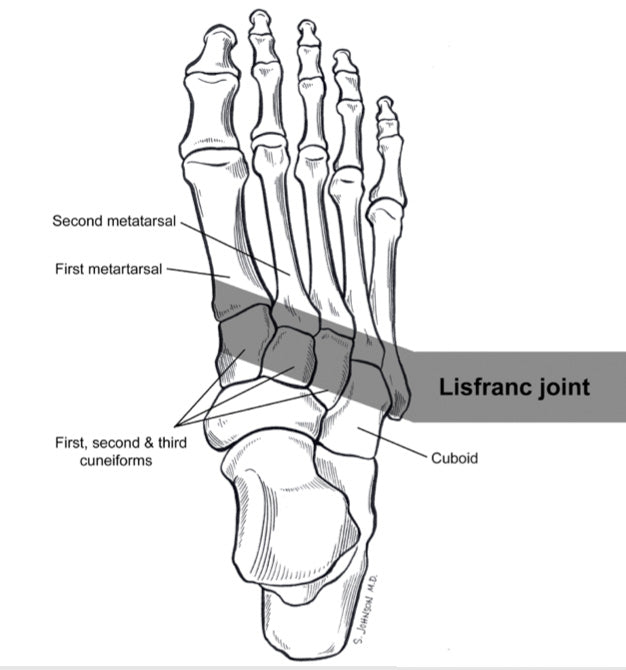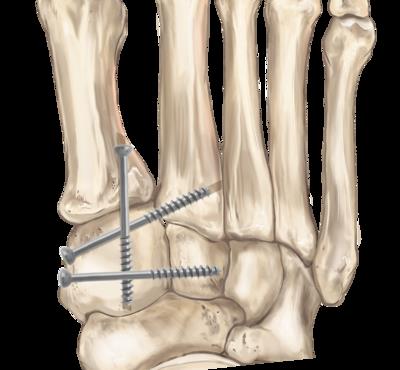Lisfranc Injury Treatment
The Lisfranc injury derives its name from the French surgeon Jacques Lisfranc de St. Martin who saw and treated injury to the midfoot region often among soldiers who fell off their horse with the foot stuck in the stirrup during his days with the Napoleonic army. Thankfully the mode of treatment has advanced significantly since that time when such foot injuries often resulted in amputation.
Lisfranc Fracture, Dislocation or Ligament Tear

The Lisfranc joint of the foot is comprised of a cluster of bones and ligaments and the base of the metatarsal bones. A twist of the foot or a fall or impact over the top of one’s foot with the foot flexed downward can fracture or dislocate the bones or cause a Lisfranc ligament tear.
Often this occurs between the first metatarsal (the big toe) and the second metatarsal, as these two bones are not connected by any tissue. Sports that have equipment with bindings over the metatarsal bones, such as snowboarding or wakeboarding, can also increase one’s risk of sustaining a Lisfranc foot injury.
Major trauma to the foot can also result in one or multiple Lisfranc injuries to the foot. This might include such things as getting stepped on by a horse, falling off a ladder, getting in an automobile accident, or a football player falling onto a blocking lineman’s raised foot. (Read about other foot injuries and conditions.)
Nonsurgical Lisfranc Sprain Treatment
The extent of the damage will determine the mode of treatment. If the Lisfranc injury does not include any fractures, major joint dislocation or complete tears to the ligament, one may be able to treat it by following the steps of RICE (rest, ice, compression, and elevation) and staying off of the foot for six weeks. During this stretch, one will have to wear a non-weight-bearing cast and use crutches.
After this period of relative immobilization of the foot has passed, the next step of Lisfranc treatment involves transitioning to a removable cast boot that can withstand weight or some other BraceAbility Short Cam Walker Boot, which is lightweight and low-profile, with an arching rocker style that promotes an energy conserving gait.
During the period of immobilization, the patient will lose muscles and flexibility. Thus, Lisfranc injury recovery will also require some physical therapy exercises once one is able to put weight on the foot again. Such exercises focus on restoring strength to your foot and leg as well as your range of motion. It typically takes around four months to fully recover from a non-operative Lisfranc injury.
Lisfranc Fracture Treatment
While the recovery time for Lisfranc injury repair is nothing to sneeze at, Lisfranc dislocation treatment and Lisfranc fracture recovery take an even longer time because they usually require either fusion or fixation surgery to repair the damaged or subluxated bones. This requires the use of hardware such as screws, pins, plates, wires, etc., that may have to be surgically removed at a later date—usually three to five months after the original procedure.
Lisfranc Surgery Recovery Time
Lisfranc surgery recovery typically begins with the patient wearing a non-weight-bearing cast boot to immobilize the foot for between six and eight weeks. After that time, he or she will usually be switched to a walking brace, such as the BraceAbility Tall Air Walker boot, and can engage in limited weight-bearing activities.

Activities involving impact, such as running or jumping, are strictly prohibited until the aforementioned hardware required for surgical repair is removed from the foot (if applicable).
Treatment for Lisfranc fracture, dislocation or a complete ligament tear will also require one to engage in strengthening and flexibility focused physical therapy, as both of these things will be compromised by the long period of inactivity. All told, Lisfranc fracture recovery time can stretch anywhere from three to six months after the operation.
Unfortunately, not everyone who sustains this injury is able to make a full recovery, and surgical fixation of the joint can still result in midfoot arthritis down the road that may require fusion surgery to remedy. The downside of fusion surgery is that it can limit the foot’s range of motion. Learn more about Lisfranc injuries and fractures










